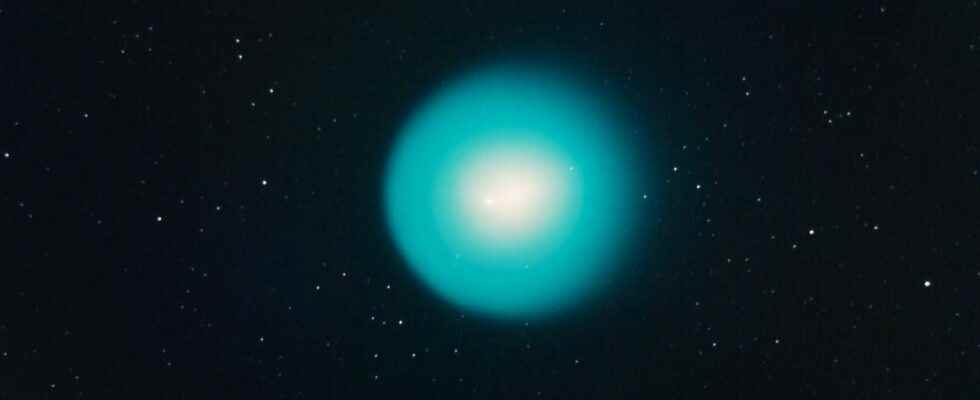In 2007, a comet was exploding in our sky. Without disintegrating. But suddenly brightening by a factor of a million! The one that the astronomers call 17P/Holmes was not his first. It is also a similar explosion, even if less spectacular, which had led to its discovery in 1892. An astonishing behavior. Perhaps due to rearrangements of the ice which constitutes the core of the comet. Rearrangements that release gas and create a pressure so strong that it ends up erupting ice, gas and dust.
What is even more remarkable is that Finnish Geospatial Research Institute astronomers argue today that the drag created by the explosion of the comet in 2007 did not disperse into space. Instead, these dusts would have concentrated on a orbit elliptical that passes through the original explosion point. And this summer, precisely, the models predict an accumulation of particles at this point – which should make the trail visible. Even with an amateur telescope. Of at least 30 cm, all the same, and equipped with a CCD camera which makes it possible to apply the method of image subtraction.
Dust to pick up
Because the particles produced by the explosion of the Comet 17P/Holmes tiny – with diameters of just fractions of a millimeter – they will still reflect the light from Sun. Making them take the form of a fuzzy trail that should appear from the end of July, on the side of the pegasus constellation.
Succeeding in locating the dust produced by explosions like those experienced by 17P/Holmes could allow astronomers to imagine a mission to collect, one day, pieces of comets. And the work done on the explosion of 2007 encourages them to model the path of the trail of the explosion of 1892. As for knowing when the next explosion of this strange comet will occur, it is currently impossible. Perhaps on the occasion of his next visit to the closer to the sunin January 2028?
In pictures: comet Holmes defies all predictions
She has been in the news for more than ten days with her huge increase in brightnessas brutal as it is inexplicable and which makes it visible to theeye naked. Enthusiasts have a field day and it has become a star of the Futura-Sciences forum, where enthusiasts exchange photos and tips. One of them, Jean-Baptiste Feldmann, tells us about the comet and presents the images collected on the forum.
Article by Jean-Baptiste Feldmann published on 08/11/2007
Since October 24, 2007, 17P/Holmes – a periodic comet which visits us every 6.9 years – has mobilized the astronomical community: its brightness has multiplied by a million in a few hours, making this star visible to the naked eye like a new star in the constellation of Perseus [que l’on voit actuellement au nord-est deux heures après le coucher du Soleil, NDLR].
The first to sound the alarm was Juan Antonio Henriquez-Santana, a Spanish amateur astronomer, followed a little later by Bob King, in Arizona, and then by the Japanese observers. Since then, Holmes has been the subject of an international following, both at the level of professional and amateur observatories.
What anyone can currently observe if you look to the northeast in the early evening is the result of the probable fragmentation of its core with the projection of blocks of ice. This phenomenon of disintegration is well known to scientists when a comet approaches too close to the sun, but it is inexplicable here, Holmes sailing between Mars and Jupiter. If the radiation from our star were able to break up comets at such distances, it would be impossible to observe the frozen moons that currently orbit these planets!
So what provides theenergy dust and ice eruptions seen on Holmes: the result of a collision with another small celestial body or an imbalance of electrical charges between the comet and the solar flux, which causes the nucleus to explode like a capacitor overloaded? Stranger still: this comet has already experienced such an event in the past, in 1896, four years after its discovery by Edwin Holmes…
Star of the moment for amateurs
While waiting for the explanations of the scientists, the amateurs are feasting. On Futura-Sciences, the images and observation reports arrived on the evening of the 24th, a few hours after the alert was given. Everyone can then spot the comet with the naked eye as a small fuzzy spot, visible despite the Moon on a photography of Scopy.
Of the drawings taken behind a telescope show a very bright nucleus with a back jet (a small tail of dust) in the center of a coma sharp and spherical. The good weather helping, the photographers come into action. Chamois performs a very nice comparison over several days, which makes it possible to measure the increase in the size of the coma. On his side, flash man use a filter infrared to highlight jets of matterwhile Vincent Becker focuses on close-ups.
As for DavidCHits treatments digital reveal disparities in the tail. Let’s not forget the work of young observers like St broc17 years old, and his very precise drawings.
Find the latest images of the comet in the section astronomical material and amateur photos.
Interested in what you just read?
